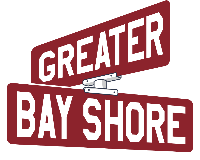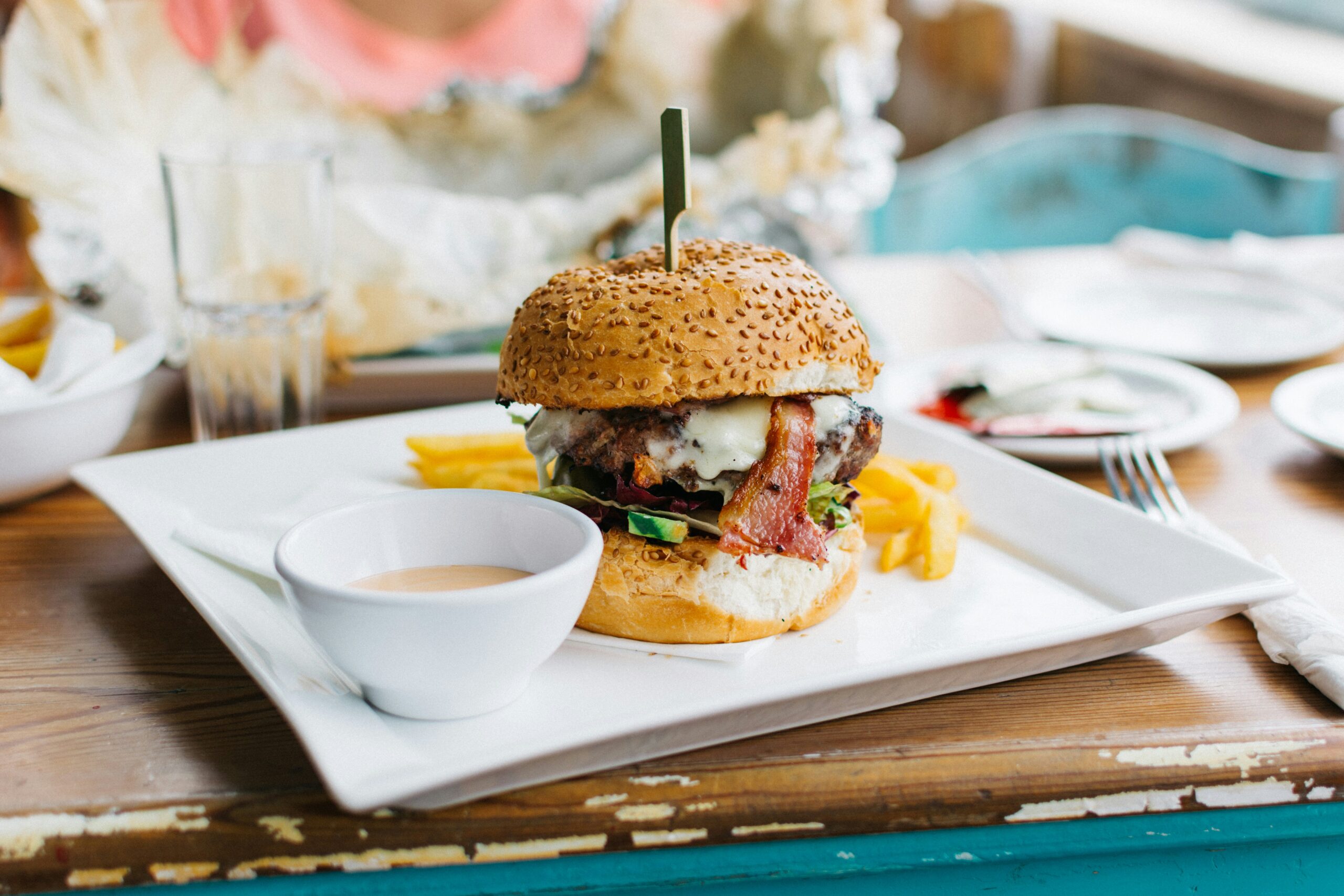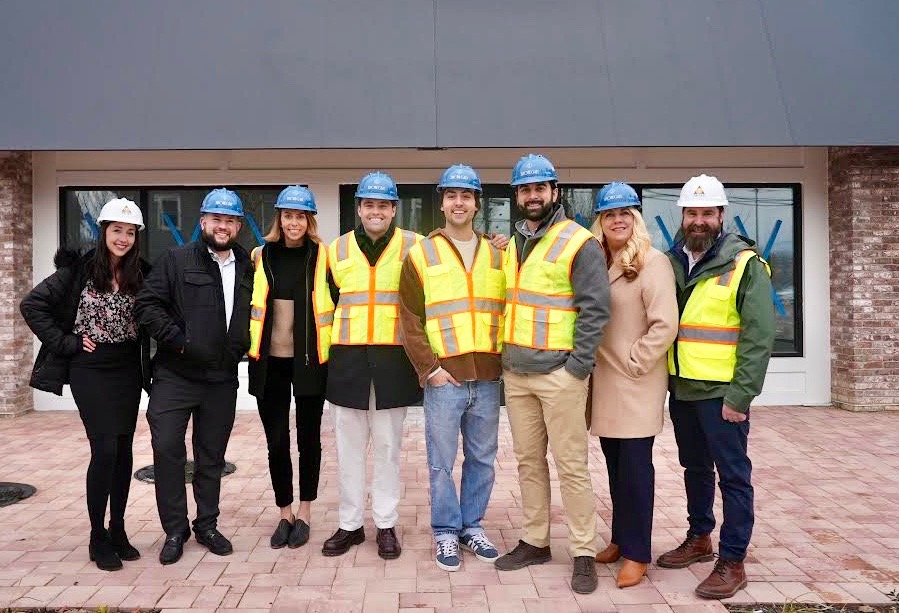
Greater Bay Shore coverage is funded in part by Shoregate, now leasing brand-new premium apartment homes in the heart of Bay Shore. Click here to schedule a tour.
Despite the overcast conditions Wednesday morning, Ethan Doutney covered his face and neck in sunblock, always at the ready in a gallon-sized pump jug on the crane boat he helms across Long Island’s south shore five days a week.
Doutney’s younger crew members on his voyages, Steven Rafalko and Angelo Casillas, abstain from the precaution despite their captain’s guidance.
“They haven’t had a bad burn yet,” Doutney, 31, of Patchogue, said. “They’ll learn.”
Doutney, a hydrophile since digging up clams for summer work as a child, planted oysters on his own farm in the Great South Bay three and a half years ago. Through networking to learn helpful tips, he secured his current role as operations manager for the Gino Macchio Foundation.
Sabrina Macchio, Gino Macchio’s sister and president of the foundation, and their parents, Steven and Deborah Macchio, created the nonprofit after Gino passed away in a motorcycle accident in 2018. Gino Macchio was in recovery as the result of a prescription opioid dependency which became an addiction. The foundation is modelled after his hopes of making Long Island’s oyster farms more efficient and restoring the ecosystem of the Great South Bay through oyster repopulation.

Ethan Doutney
put recovery to work
The foundation has a “put recovery to work” program, through which it employs addicts after they go through rehab, mirroring Macchio’s recovery.
One such employee is Rafalko, who said he checked into rehab to abandon “bad decisions and following a bad crowd” after contemplating the frequency of his usage and his future.

Steven Rafalko
He said he was in rehab for one month as an in-patient before his counselor aimed to find him work.
“This was the first one I heard and they got back to me very soon,” Rafalko, 20, of West Babylon, said after donning his waders to hop in the waste-deep water. “I tried it out like a week later and I enjoyed it. Everyone was happy with me.”

The foundation’s mantra is “I got you,” a phrase Gino Macchio frequently said
Doutney said he has worked with a handful of recovering addicts through the program before Rafalko. Throughout the day, he guides Rafalko, as well as Casillas, through properly lifting gear without strain, sorting oysters and driving the crane boat.
“This is a good job because it’s a structured and meaningful job in nature,” he said. “You work with your hands. [Rafalko’s] life is 10 times better now because he loves his job. I’m from Long Island, I got a bunch of friends who died of drugs. I know the world’s on fire, so I’m happy to help.”
‘the water cooler’
Macchio drew designs for equipment he believed could make the bay’s farmers more efficient. His father found those drawings after his passing which inspired the construction of a multi-purpose machine stationed on a barge the foundation controls. Oysters are poured into a tumbler and pruned, put on a conveyer belt and sorted into shoots.
“It promotes better growth and helps you keep your farm organized,” Doutney said. “It grows with a deeper cup and it has a smoother finish on the shell. A nice shell helps you get a better price for your oysters. All the farmers line up to use this thing.”

The machine based on Gino Macchio’s designs
One such farmer on this Wednesday afternoon was Colby Doyon, who said the machine cuts time and labor costs.
“I use this a couple a times a week,” Doyon, 33, said. “I can get done with this in a day what would take a full week otherwise just with manually splitting. Plus it improves the quality of the oyster in a way that just manually splitting wouldn’t.”
“This is like the water cooler,” Doutney said of the barge. “We’ll be working and boats will pull up and guys will take their lunch break and then we talk to each other. That’s valuable, we got to stick together to whether the storm, sometimes literally.”
restoring the Great South Bay
Gino Macchio worked on JA Cochrane and Sons’ oyster farm after rehab. After Macchio’s passing, the plot was donated to the foundation bearing his name.
On this Wednesday, as the clouds parted, Doutney, Rafalko and Casillas worked on that farm Macchio worked.

Angelo Casillas
Rafalko and Casillas removed the farm’s “ghost gear,” 50 pound, seaweed and sponge covered empty oyster cages not needed until next spring. Meanwhile, Doutney tended to some of his babies: oysters grown to fulfill the foundation’s mission to restore the Great South Bay’s ecosystem.
An oyster is a natural filtration systems that can refine 50 gallons of water a day, removing nitrogen and other pollutants. The foundation hopes repopulating the reef along the shores of Bellport with oysters will improve the bay’s water quality.

Doutney’s farm
When repopulation began, the group was not sure if farmers would be willing to participate, so the Cochrane plot was dedicated to growing repopulation oysters. The farmers came through, as Doyon said he donated 20,000 oysters last year and approximately another 10,000 this year.
Before their day wrapped, Doutney and Casillas hopped on the barge to sort Doutney’s personal oysters to sell to a distributor the next day.

Sorting on the barge
Casillas said they were removing the “small, super-jumbo and doubles.” Some of those will continue to grow in the water while others will find themselves filtering the Great South Bay.
By the end of this year, the foundation will have donated 250,000 oysters to a reef over one million strong.

A double, unmarketable but great for repopulation
the biggest challenge: selling the real Blue Point oyster
Doutney said the foundation has been crucial in reviving the oyster industry out of the Great South Bay and has provided hope for the future of the bay’s health and industry.
“I’m glad I’m young enough that I’ll see the Great South Bay come back in my lifetime,” he said.
But the biggest challenge he and other farmers still face is selling their Blue Point oysters grown in the Great South Bay. Doutney said other distributors beyond the island sell falsely labeled Blue Point oysters that are bred elsewhere.
“We have no power in the marketplace,” Doutney said. “We want to educate that ours oysters are the best and raise customer demand for authentic Blue Point oysters.”
Doutney said selling one million oysters grown on his personal farm every year at market and selling to New York City are his goals in the next five years.
“We have some of the best oysters in the world, yet New York City is buying oysters from other places in the world,” he said.” That’s the thing that keeps me up at night, getting a fair price and trying to sell the oysters. I have hundreds of thousands of oysters on my farm that I need to sell. Where are they gonna go?”
[Editor’s note: This report has been updated for accuracy and sensitivity.]

The trio’s lunch break on the move. Doutney packed a panini with grilled chicken, mozzarella and tomato

“We gotta have Goldfish,” Casillas said. “And we’re big on the Cheez-Its.”

































